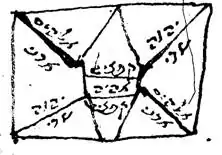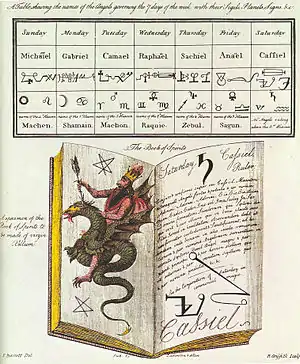Cassiel
Cassiel (Hebrew: קפציאל Qafṣiʼel; Arabic: كسفيائيل, Kasfiyāʼil),[1][2][3][4][5][6][7] (also known as Cafziel, Cafzyel, Caphziel,[3][8] Casiel,[9] Cassael,[3][6][10] Casziel,[3][8][9] Kafziel,[9][11][12] Kassiel, Kasiel,[3] Qafsiel,[13] Qaphsiel,[12][13][14] Qaspiel,[13][15] Qephetzial,[16] or Quaphsiel),[13] meaning "God is my cover", "Cover of God", "Speed of God"[12] or "God is my anger"[15] is an angel appearing in extracanonical Jewish, Christian, and Islamic mystical and magical works, often as one of the Seven Archangels, the angel of Saturn,[1][2][3][4][5][6][7][8][10][11][16] and in other roles.
In Jewish mystical literature

Qaphsiel is invoked in an ancient Hebrew charm to tell if an enemy is running away.[13][14] Gustav Davidson writes that Qafsiel is described as the ruler of the seventh heaven in 3 Enoch, citing Odeberg's edition.[13] However, Odeberg's edition only states in a footnote that Qafsiel is "(one of) the guardian(s) of the door of the seventh Hall" in Hekhalot Rabbati.[17] In turn, Qaspiel is described in Hekhalot Rabbati as a guardian of the sixth palace, armed with a lightning-dripping sword (which shouts "Ruin!") as well as a bow, tempests, light, and powerful winds—weapons which he uses against anyone not fit to see God. Qaspiel is later described in the same work as one of three "guardians of the entrance of the seventh palace," alongside Dumiel and Gabriel. Qaspiel is also listed in Ma'aseh Merkavah as a guardian of the second palace.[15] Sefer Raziel lists Qephetzial as the prince of Saturn.[16] The Zohar describes Kafziel as one of the two chief aides (alongside Hizikiel) to Gabriel.[12]
In western occult literature

Cassiel is listed in the related works The Sworn Book of Honorius[3][8] and in (pseudo)-Peter de Abano's Heptameron[2][3] (the latter also influenced by Sefer Raziel).[2] Cassiel's presence in Honorius may also be a result of Greek influence, as he is likewise listed in a Byzantine exorcism manual (as Kasiel).[3] In these works, he is, as usual, listed as the angel of Saturn but also as the angel of the North and as one of the angels named in the Sigillum Dei.[2][3][8] Following Honorius and the Heptameron, Cassiel appears in the Liber de Angelis as Cassael (again the angel over Saturn),[3][10] then in various editions of the Key of Solomon as Cassiel or Cassael, angel (sometimes archangel) over Saturn or Saturday,[4][5][6] and once again in the Sigillum Dei.[18] Cassiel is depicted in Francis Barrett's The Magus as a dragon-riding jinn with a beard, again as the angel over Saturn.[7][9][19]
Other works
Cassiel is sometimes described as the angel of tears, the angel of temperance,[9] or the angel who presides over the deaths of kings.[12] As Qafsiel, he is sometimes regarded as the ruler of the moon instead of Saturn.[12][13]
Averroes and Ibn Arabi likewise listed Saturn as the planetary counterpart of the archangel Kafziel.[11][20] Ahmad al-Buni listed Kasfiyail as one of eight angels, among whom each has its own hierarchy of spirits under command.[21]
In popular culture
- Cassiel is the main protagonist in The Outcast Season series by Rachel Caine.[22]
- Cassiel appears in Wim Wenders's film Wings of Desire, as well as the U.S. remake, City of Angels. Wenders found the name in an encyclopedia about angels.[23] Cassiel, played by Otto Sander in the original and Andre Braugher in the remake, watches with considerable ambivalence as his friend becomes human. In the sequel Faraway, So Close!, Cassiel himself becomes human. Nick Cave wrote "Cassiel's Song" as part of the music for that film.
See also
References
- Davidson, Gustav (1971). A Dictionary of Angels, Including the Fallen Ones. Simon & Schuster. pp. 82, 164, 233.
- de Abano (Pseudo), Peter (1998). Peterson, Joseph (ed.). "Heptameron, or Magical Elements". Twilit Grotto: Esoteric Archives.
- Honorius of Thebes (2016). Peterson, Joseph (ed.). The Sworn Book of Honorius: Liber Iuratus Honorii. Ibis Press. pp. 19, also 33n, 201, 209, 213, 219, 221, 271.
- Skinner, Stephen; Rankine, David, eds. (2008). The Veritable Key of Solomon. Llewellyn Worldwide. pp. 108, 126, 141, 156, 172, 188, 202, 246–248.
- Sibly, Ebenezer; Hockley, Frederick (2009). Peterson, Joseph (ed.). The Clavis or Key to the Magic of King Solomon. Ibis Press. pp. 62, 81, 98, 116, 134, 153, 171, 173, 180, 253, 281, 310–311, 326, 347, 350, 353, 356, 359, 363, 366, 392, 412.
- Mathers, S.L MacGregor (1999). Peterson, Joseph (ed.). "The Key of Solomon (Clavicula Salomonis)". Twilit Grotto: Esoteric Archives. p. Tables 2 and 3.
- Barrett, Francis. The Magus. Internet Sacred Text Archive. pp. 126, 139.
- Honorius of Thebes (2002). Hedegård, Gösta (ed.). Liber Iuratus Honorii: A Critical Edition of the Latin Version of the Sworn Book of Honorius. Almquist & Wiksell International. pp. 117 (CV 1), 120 (CXIV 5), 121 (CXV 6), 123 (CXV 31), 124 (CXV 44), 224.
- Davidson, p. 82.
- Lidaka, Juris D. (1998). "The Book of Angels, Rings, Characters, and Images of the Planets: Attributed to Osbern Bokenham". In Fanger, Claire (ed.). Conjuring Spirits. Penn State University Press. pp. 64–73.
- Guiley, Rosemary Ellen (2004). The Encyclopedia of Angels. Facts on File. p. 44.
- Davidson, p. 164.
- Davidson, p. 233.
- Thompson, R.C. (1908). Semitic Magic: Its Origins and Development. Luzac & Co. pp. 186–187.
- Davila, James R. (2013). Hekhalot Literature in Translation. Brill Publishers. pp. 104, 116–117, 283.
- Steve, Savedow, ed. (2000). Sepher Rezial Hemelech. Weiser Books. pp. 119, 210.
- Rabbi (Pseudo)-Ishmael (1928). Odeberg, Hugo (ed.). 3 Enoch or The Hebrew Book of Enoch. Cambridge University Press. p. 54.
- Mathers, p. 1.18.
- Gettings, Fred (1988). Dictionary of Demons. Guild Publishing. p. 64b (plate).
- http://ankaenstitusu.com/kozmolojik-bir-kagan-oguz-kagan/ (Turkish)
- Nünlist, Tobias (2015). Dämonenglaube im Islam (in German). Berlin, Germany: Walter de Gruyter p. 401 ISBN 978-3-110-33168-4
- Caine, Rachel. "The Outcast Season Series". ROC. Archived from the original on December 23, 2010. Retrieved October 3, 2015.
- Wenders, Wim (9 November 2009). "On Wings of Desire". The Criterion Collection. Retrieved 5 July 2017.